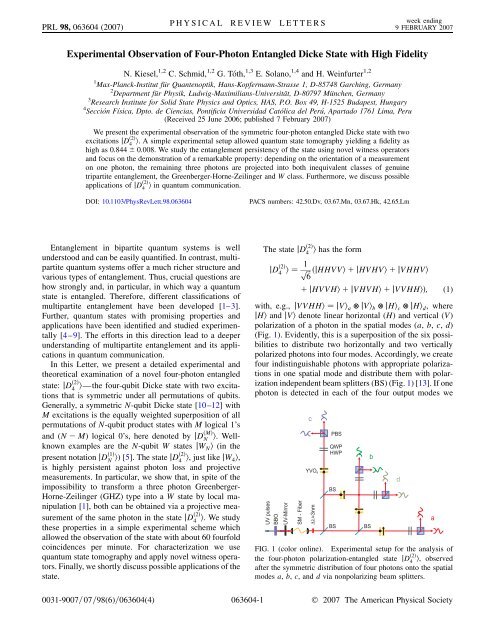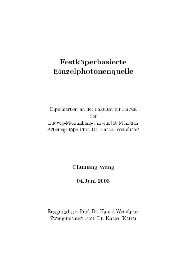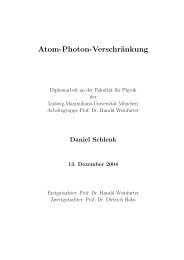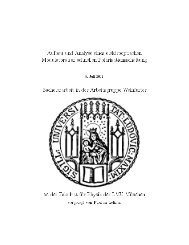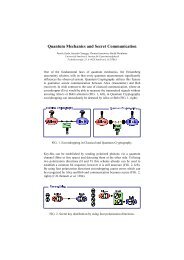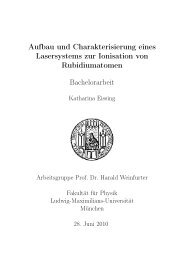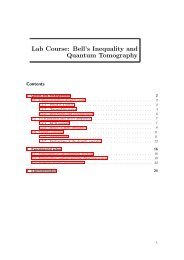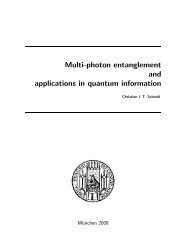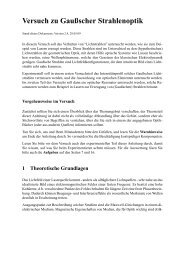PRL - The Budapest Quantum Optics Group
PRL - The Budapest Quantum Optics Group
PRL - The Budapest Quantum Optics Group
Create successful ePaper yourself
Turn your PDF publications into a flip-book with our unique Google optimized e-Paper software.
<strong>PRL</strong> 98, 063604 (2007)<br />
PHYSICAL REVIEW LETTERS week ending<br />
9 FEBRUARY 2007<br />
Experimental Observation of Four-Photon Entangled Dicke State with High Fidelity<br />
N. Kiesel, 1,2 C. Schmid, 1,2 G. Tóth, 1,3 E. Solano, 1,4 and H. Weinfurter 1,2<br />
1 Max-Planck-Institut für Quantenoptik, Hans-Kopfermann-Strasse 1, D-85748 Garching, Germany<br />
2 Department für Physik, Ludwig-Maximilians-Universität, D-80797 München, Germany<br />
3 Research Institute for Solid State Physics and <strong>Optics</strong>, HAS, P.O. Box 49, H-1525 <strong>Budapest</strong>, Hungary<br />
4 Sección Física, Dpto. de Ciencias, Pontificia Universidad Católica del Perú, Apartado 1761 Lima, Peru<br />
(Received 25 June 2006; published 7 February 2007)<br />
We present the experimental observation of the symmetric four-photon entangled Dicke state with two<br />
excitations jD 2<br />
4<br />
i. A simple experimental setup allowed quantum state tomography yielding a fidelity as<br />
high as 0:844 0:008. We study the entanglement persistency of the state using novel witness operators<br />
and focus on the demonstration of a remarkable property: depending on the orientation of a measurement<br />
on one photon, the remaining three photons are projected into both inequivalent classes of genuine<br />
tripartite entanglement, the Greenberger-Horne-Zeilinger and W class. Furthermore, we discuss possible<br />
applications of jD 2<br />
4 i in quantum communication.<br />
DOI: 10.1103/PhysRevLett.98.063604<br />
PACS numbers: 42.50.Dv, 03.67.Mn, 03.67.Hk, 42.65.Lm<br />
Entanglement in bipartite quantum systems is well<br />
understood and can be easily quantified. In contrast, multipartite<br />
quantum systems offer a much richer structure and<br />
various types of entanglement. Thus, crucial questions are<br />
how strongly and, in particular, in which way a quantum<br />
state is entangled. <strong>The</strong>refore, different classifications of<br />
multipartite entanglement have been developed [1–3].<br />
Further, quantum states with promising properties and<br />
applications have been identified and studied experimentally<br />
[4–9]. <strong>The</strong> efforts in this direction lead to a deeper<br />
understanding of multipartite entanglement and its applications<br />
in quantum communication.<br />
In this Letter, we present a detailed experimental and<br />
theoretical examination of a novel four-photon entangled<br />
state: jD 2<br />
4<br />
i—the four-qubit Dicke state with two excitations<br />
that is symmetric under all permutations of qubits.<br />
Generally, a symmetric N-qubit Dicke state [10–12] with<br />
M excitations is the equally weighted superposition of all<br />
permutations of N-qubit product states with M logical 1’s<br />
and (N M) logical 0’s, here denoted by jD M N i. Wellknown<br />
examples are the N-qubit W states jW N i (in the<br />
present notation jD 1 2<br />
N i)[5]. <strong>The</strong> state jD4 i, just like jW 4i,<br />
is highly persistent against photon loss and projective<br />
measurements. In particular, we show that, in spite of the<br />
impossibility to transform a three photon Greenberger-<br />
Horne-Zeilinger (GHZ) type into a W state by local manipulation<br />
[1], both can be obtained via a projective measurement<br />
of the same photon in the state jD 2<br />
4<br />
i. We study<br />
these properties in a simple experimental scheme which<br />
allowed the observation of the state with about 60 fourfold<br />
coincidences per minute. For characterization we use<br />
quantum state tomography and apply novel witness operators.<br />
Finally, we shortly discuss possible applications of the<br />
state.<br />
<strong>The</strong> state jD 2<br />
4<br />
i has the form<br />
jD 2<br />
4 i 1<br />
p jHHVVi<br />
6<br />
jHVHVi jVHHVi<br />
jHVVHi jVHVHi jVVHHi ; (1)<br />
with, e.g., jVVHHi jVi a jVi b jHi c jHi d , where<br />
jHi and jVi denote linear horizontal (H) and vertical (V)<br />
polarization of a photon in the spatial modes (a, b, c, d)<br />
(Fig. 1). Evidently, this is a superposition of the six possibilities<br />
to distribute two horizontally and two vertically<br />
polarized photons into four modes. Accordingly, we create<br />
four indistinguishable photons with appropriate polarizations<br />
in one spatial mode and distribute them with polarization<br />
independent beam splitters (BS) (Fig. 1)[13]. If one<br />
photon is detected in each of the four output modes we<br />
FIG. 1 (color online). Experimental setup for the analysis of<br />
the four-photon polarization-entangled state jD 2<br />
4 i, observed<br />
after the symmetric distribution of four photons onto the spatial<br />
modes a, b, c, and d via nonpolarizing beam splitters.<br />
0031-9007=07=98(6)=063604(4) 063604-1 © 2007 <strong>The</strong> American Physical Society
<strong>PRL</strong> 98, 063604 (2007)<br />
PHYSICAL REVIEW LETTERS week ending<br />
9 FEBRUARY 2007<br />
063604-2<br />
FIG. 2 (color online). (a) Real part of the density matrix fit<br />
derived from the observed data, (b) density plot of the ideal state<br />
and, for comparison, (c) the difference between the matrices.<br />
Noise on the real and imaginary part is<br />
D 2<br />
4<br />
comparable.<br />
observe the state jD 2<br />
4<br />
i. This occurs with a probability of<br />
p 0:094 for ideal 50:50 BS and p 0:080 experimentally<br />
[14,15].<br />
As source of the four photons we use the second order<br />
emission of collinear type-II spontaneous parametric down<br />
conversion (SPDC). UV pulses with a central wavelength<br />
of 390 nm and an average power of about 600 mW from a<br />
frequency-doubled mode-locked Ti:sapphire laser (pulse<br />
length 130 fs) are used to pump a 2 mm thick BBO<br />
( -barium borate, type-II) crystal. This results in two<br />
horizontally and two vertically polarized photons with<br />
the same wavelength. Dichroic uv mirrors serve to separate<br />
the uv-pump beam from the down conversion emission. A<br />
half-wave plate together with a 1 mm thick BBO crystal<br />
compensates walk-off effects (not shown in Fig. 1).<br />
Coupling the four photons into a single mode fiber exactly<br />
defines the spatial mode. <strong>The</strong> spectral selection is achieved<br />
with a narrow bandwidth interference filter ( 3nm)<br />
at the output of the fiber. Birefringence in the nonpolarizing<br />
beam splitter cubes (BS) is compensated with pairs of<br />
perpendicularly oriented 200 m thick birefringent<br />
yttrium-vanadate crystals (YVO 4 ) in each of the four<br />
modes. Altogether, the setup is stable over several days<br />
which is mainly limited by misalignment effects in the<br />
pump laser system affecting rather the count rate than the<br />
quality of the state.<br />
Polarization analysis is performed in all of the four<br />
outputs. For each mode we choose the analysis direction<br />
with half and quarter wave plates and detect the photons<br />
with the corresponding orthogonal polarizations in the<br />
outputs of polarizing beam splitters (PBS) using single<br />
photon detectors. <strong>The</strong> detected signals are fed into a multichannel<br />
coincidence unit which allows us to simultaneously<br />
register any possible coincidence between the<br />
inputs. <strong>The</strong> rates for each of the 16 characteristic fourfold<br />
coincidences were corrected for the different detection<br />
efficiencies in each polarization analysis.<br />
To analyze the observed state we first determine its<br />
density matrix. For this purpose we measure the correlations<br />
Tr exp i j k l with i, j, k, l 2<br />
f0;x;y;zg, where i are the Pauli spin operators. <strong>The</strong>se<br />
256 values can be derived from the 81 settings of all<br />
combinations for analyzing each qubit in one of the three<br />
bases:<br />
p<br />
(H=V), ( 45 ) and (L=R),<br />
p<br />
where j 45 i<br />
1= 2 jHi jVi and jL=Ri 1= 2 jHi ijVi . <strong>The</strong><br />
measurement was running 35 h with a count rate of about<br />
60 fourfold coincidences per minute. <strong>The</strong> obtained data<br />
completely characterize the observed state ( exp )upto<br />
statistical errors, resulting in a fidelity of F exp 0:844<br />
0:008. We use a maximum likelihood approach to estimate<br />
a corresponding physical density matrix fit . <strong>The</strong> real part<br />
of fit is depicted in Fig. 2(a). <strong>The</strong> characteristic structure<br />
of the ideal state [Fig. 2(b)] is clearly visible. For<br />
D 2<br />
4<br />
comparison Fig. 2(c) shows the differences between the<br />
matrices. <strong>The</strong> noise is about the same in the imaginary part<br />
and is mainly caused by higher order emissions and imperfect<br />
compensation of the birefringence of fiber and<br />
beam splitters. <strong>The</strong> major difference is in the off diagonal<br />
elements: due to the finite spectral bandwidth the coherence<br />
gets reduced. This can be improved with narrower<br />
filters but at the expense of lower count rates.<br />
To test whether we indeed observe genuine four-partite<br />
entanglement we use the generic form of the witness<br />
operator W g [16]. <strong>The</strong> corresponding expectation value<br />
depends directly on the observed fidelity: Tr W g exp<br />
2<br />
3<br />
F exp 0:177 0:008 [17] and is positive for all<br />
biseparable states. In principle, 21 measurement settings,<br />
instead of the experimentally expensive complete tomography,<br />
are sufficient to determine this value.<br />
For jD 2<br />
4<br />
i one can, however, construct an entanglement<br />
witness that is much more efficient. Using the high symmetry<br />
of this state, genuine four-partite entanglement can<br />
be detected with only two settings via a measurement of<br />
the collective spin squared in x- and y direction (hJxi 2 and<br />
hJyi). 2 For biseparable states it can be proven that [18,19]<br />
hW s 4 i p<br />
hJ2 xi hJyi 2 7=2 3<br />
5:23; (2)<br />
where J x=y 1=2 P k<br />
k x=y with, e.g., 3 x 1 1 x 1.<br />
This can be interpreted also by rewriting hJxi<br />
2 hJyi<br />
2<br />
hJ 2 i hJzi 2 where J J x ;J y ;J z . As for symmetric states<br />
p<br />
hJ 2 i N=2 N=2 1 our criterion requires hJzi 2 5=2<br />
3 ; i.e., the collective spin squared of biseparable symmetric<br />
states in any direction cannot be arbitrarily small<br />
[20]. For the state jD 2<br />
4 i, however, hJ2 zi 0 and thus the<br />
expectation value of the witness operator in Eq. (2) reaches<br />
the maximum of 6. Via measurement of all photons in<br />
( 45) basis and (L=R) basis, respectively, we find experimentally<br />
the value Tr W s 4 exp 5:58 0:02 clearly exceeding<br />
the required bound. Multipartite entanglement<br />
was, thus, detected by studying only a certain property of
<strong>PRL</strong> 98, 063604 (2007)<br />
PHYSICAL REVIEW LETTERS week ending<br />
9 FEBRUARY 2007<br />
the state and can, in principle, even be detected without<br />
individual addressing of qubits.<br />
Let us start the investigation of the properties that make<br />
jD 2<br />
4 i special in comparison with the great variety of other<br />
four-qubit entangled states studied so far. <strong>The</strong> various<br />
states show great differences in the residual three-qubit<br />
state dependent on the measurement basis and/or result:<br />
jGHZ 4 i [7] can either still render tripartite GHZ-like entanglement<br />
or become separable, jW 4 i as well, but the<br />
tripartite entanglement will always be W type. Entanglement<br />
in the cluster state jC 4 i [6] cannot be easily destroyed<br />
and at least bipartite entanglement remains. However,<br />
jD 2<br />
4 i and also j 4 i [9,21] yield genuinely tripartite entangled<br />
states independent of the measurement result and<br />
basis.<br />
Let us compare the projection of the qubit in mode d<br />
onto either jVi or j i for the state jD 2<br />
4 i:<br />
d hVjD 2<br />
4 i 1<br />
p jHHVi<br />
3<br />
jHVHi jVHHi ;<br />
d h jD 2<br />
4 i 1<br />
p jHHVi<br />
6<br />
jHVHi jVHHi jHVVi<br />
jVHVi jVVHi : (3)<br />
<strong>The</strong> first is the state jW 3 i [4] and the second one is a socalled<br />
G state (jG 3 i Ref. [22]). Experimentally we observe<br />
these states with fidelities F W3<br />
0:882 0:015 and<br />
F G3<br />
0:897 0:019. Comparable values are observed<br />
for measurements of photons in other modes. <strong>The</strong> real<br />
part of the density matrices of the experimental results<br />
are depicted in Fig. 3. Density matrix (a) shows the measurement<br />
result for the state jW 3 i. In (b) the observed G<br />
state is shown containing the entries for jW 3 i, its spinflipped<br />
counterpart jW 3 i and, with the negative sign, the<br />
coherence terms between the two. Noise in the imaginary<br />
part is comparable to the one in the real part.<br />
<strong>The</strong> criterion (2) adopted to the three-qubit case, can<br />
now be used to detect the tripartite entanglement around<br />
p<br />
jW 3 i and jG 3 i with the bound hW s 3 i hJ2 xi hJyi 2 2<br />
5 =2 3:12. Our measurement results for jW3 i and jG 3 i<br />
are Tr W s 3 G 3<br />
3:34 0:03 and Tr W s 3 W 3<br />
3:33<br />
0:03, respectively, which proves both states contain genuine<br />
tripartite entanglement.<br />
What kind of tripartite entanglement do we observe<br />
Fascinatingly, this depends on the measurement basis.<br />
While the W state represents the W class, the state jG 3 i<br />
belongs to the GHZ class. This is extraordinary: GHZ and<br />
W class states cannot be transformed into one another via<br />
stochastic local operations and classical communication<br />
(SLOCC) [1] and not even by entanglement catalysis<br />
[23]. jD 2<br />
4<br />
i, however, can be projected into both classes<br />
by a local operation, i.e., via a simple von Neumann measurement<br />
of one qubit. This also implies that there is no<br />
obvious way to obtain jD 2<br />
4<br />
i out of either of those threequbit<br />
states via a 2-qubit interaction with an additional<br />
photon, as this would directly give a recipe to transform<br />
one class of three-qubit entanglement into the other. As the<br />
experimentally observed states are not perfect we also have<br />
to test whether the observed state jG 3 i is GHZ class. To do<br />
so we construct an entanglement witness from the generic<br />
3<br />
one for pure GHZ states, W GHZ3 4 1 jGHZ 3ihGHZ 3 j,<br />
by applying local filtering operations ^F A B C. <strong>The</strong><br />
resulting witness operator is then W 0 ^F y W GHZ3<br />
^F<br />
[5,24]. Here A, B, and C are 2 2 complex matrices<br />
determined through numerical optimization to find an optimal<br />
witness for the detected state. Note that W 0 still<br />
detects GHZ type entanglement as ^F is an SLOCC operation.<br />
In the measurement GHZ type entanglement is indeed<br />
detected with an expectation value of Tr GW 0<br />
0:029 0:023 proving that the observed state is not W<br />
class.<br />
Entanglement in jD 2<br />
4<br />
i is not only persistent against<br />
projective measurements but also against loss of photons.<br />
<strong>The</strong> state abc after tracing out qubit d is an equally<br />
weighted mixture of jW 3 i and jW 3 i, which is also tripartite<br />
entangled [Fig. 3(c)]. Applying witness W s 3 we obtain<br />
Tr W s 3 abc 3:30 0:01, proving clearly the genuine<br />
tripartite entanglement. <strong>The</strong> fidelity with respect to the<br />
expected state is F abc 0:924 0:006, similar values<br />
are reached for the loss of the photons in modes a, b,<br />
and c. We observe the contributions of jW 3 i and jW 3 i,<br />
but contrary to the state jG 3 i [Fig. 3(b)] there is no coherence<br />
between the two.<br />
As we have seen, the loss of one photon results in a<br />
three-qubit entangled W class state. Thus, the persistency<br />
against the loss of a second photon should also be high<br />
[21]. It is known that the state jW 4 i is the symmetric state<br />
with the highest persistency against loss of two photons<br />
with respect to entanglement measures like the concurrence<br />
[1,11]. In contrast, it turns out that for jD 2<br />
4 i the<br />
FIG. 3 (color online). Real parts of<br />
density matrices for (a) W state after<br />
projection of photon d onto jVi, (b) G<br />
state after projection of photon d onto<br />
j i, (c) residual state after loss of photon<br />
d. <strong>The</strong> imaginary parts consist of noise<br />
only, comparable to the noise in the real<br />
part.<br />
063604-3
<strong>PRL</strong> 98, 063604 (2007)<br />
PHYSICAL REVIEW LETTERS week ending<br />
9 FEBRUARY 2007<br />
remaining two photons have the highest possible maximal<br />
singlet fraction (MSF) [25] (MSF D<br />
2 2=3, experimentally<br />
MSF exp 0:624 0:005). This means that the resid-<br />
4<br />
ual state is as close to a Bell state as possible. It was already<br />
pointed out in Refs. [21,25] that this is a hint for the<br />
applicability of a state for telecloning [26]. Four parties<br />
that share the state jD 2<br />
4<br />
i can use the quantum correlations<br />
in each pair of qubits as a quantum channel for a teleportation<br />
protocol. Thus, each party can distribute an input<br />
qubit to the other parties with a certain fidelity, which<br />
depends on the MSF. Using jD 2<br />
4<br />
i as quantum resource<br />
this so-called 1 ! 3 telecloning works with the optimal<br />
fidelity allowed by the no-cloning theorem. Averaged over<br />
arbitrary input states the fidelity is F1!3 clone 0:788 and the<br />
optimal so-called covariant cloning fidelity is F1!3<br />
cov<br />
0:833 for all input states on the<br />
p<br />
equatorial plane of the<br />
Bloch sphere [i.e., all states 1= 2 jHi e<br />
i<br />
jVi ].<br />
What if the receiving parties decide that one of them<br />
should get a perfect version of the input state<br />
Probabilistically this is still possible, if the other two<br />
parties abandon their part of the information by a measurement<br />
of their qubit in the same direction, say (H=V). In<br />
case they find orthogonal measurement outcomes the<br />
sender and the only remaining receiver share a Bell state<br />
cd hHVjD 2<br />
4 i 1= p 3<br />
p<br />
jHVi jVHi 2=3 j i ab . This<br />
enables perfect teleportation in 2=3 of the cases and therefore,<br />
as each party could be the receiver, an open destination<br />
teleportation (ODT) [8]. <strong>The</strong> experimentally obtained<br />
fidelity in this case was F Hc V d<br />
0:883 0:028. For other<br />
measurement directions different Bell states can be obtained.<br />
For example, for projections onto the ( 45) basis<br />
and (L=R) basis we found F c d<br />
0:721 0:043 and<br />
F Rc L d<br />
0:712 0:042. Note that, in contrast to the deterministic<br />
GHZ based ODT protocol, jD 2<br />
4 i allows us to<br />
choose between telecloning and ODT.<br />
Finally, as another possible application, we also note<br />
that jD 2<br />
4<br />
i is one of the two symmetric Dicke states which<br />
can be used in certain quantum versions of classical games<br />
[27]. In these models it might offer new game strategies<br />
compared to the commonly used GHZ state.<br />
In conclusion, we have presented the experimental<br />
analysis of the quantum state jD 2<br />
4<br />
i, obtained with a fidelity<br />
of 0:844 0:008 and a count rate as high as<br />
60 counts=min. <strong>The</strong> setup and methods used are generic<br />
for observation of symmetric Dicke states with higher<br />
photon numbers. An analysis of the state after projection<br />
of one qubit in different bases showed that the two inequivalent<br />
classes of genuine tripartite entanglement can be<br />
obtained. An optimized entanglement witness served to<br />
verify this experimentally. We also show that the possibility<br />
to project two photons into a Bell state makes jD 2<br />
4 i a<br />
resource for an ODT protocol. Further, the state has a high<br />
entanglement persistency against loss of two photons. In<br />
this case, the MSF of the remaining photons is maximal<br />
063604-4<br />
and from this we inferred applicability of the state for<br />
quantum telecloning. <strong>The</strong> extraordinary properties of the<br />
state make many more applications very likely in the<br />
future.<br />
We acknowledge the support of this Letter by the<br />
Bavarian High-tech Initiative, the Deutsche Forschungsgemeinschaft,<br />
the European Commission through the EU<br />
Projects QUAP and RESQ and the EU Grants Nos. MEIF-<br />
CT-2003-500183 and MERG-CT-2005-029146, and the<br />
National Research Fund of Hungary OTKA (Contract<br />
No. T049234).<br />
[1] W. Dür et al., Phys. Rev. A 62, 062314 (2000).<br />
[2] F. Verstraete et al., Phys. Rev. A 65, 052112 (2002).<br />
[3] L. Chen and Y. Chen, Phys. Rev. A 74, 062310 (2006).<br />
[4] N. Kiesel et al., J. Mod. Opt. 50, 1131 (2003); M. Eibl<br />
et al., Phys. Rev. Lett. 92, 077901 (2004).<br />
[5] H. Häffner et al., Nature (London) 438, 643 (2005).<br />
[6] N. Kiesel et al., Phys. Rev. Lett. 95, 210502 (2005);<br />
P. Walther et al., Nature (London) 434, 169 (2005).<br />
[7] A. Zeilinger et al., Phys. Rev. Lett. 78, 3031 (1997); J. Pan<br />
et al., Phys. Rev. Lett. 86, 4435 (2001).<br />
[8] Z. Zhao et al., Nature (London) 430, 54 (2004).<br />
[9] M. Eibl et al., Phys. Rev. Lett. 90, 200403 (2003);<br />
S. Gaertner et al., J. Appl. Phys. B 77, 803 (2003).<br />
[10] R. H. Dicke, Phys. Rev. 93, 99 (1954).<br />
[11] J. K. Stockton et al., Phys. Rev. A 67, 022112 (2003).<br />
[12] A. Retzker, E. Solano, and B. Reznik, quant-ph/0605048.<br />
[13] A similar scheme was proposed for other purposes by<br />
T. Yamamoto et al., Phys. Rev. A 66, 064301 (2002).<br />
[14] Nikolai Kiesel, Ph.D. thesis, LMU München (to be published).<br />
[15] Note, the complete state of the four photons exhibits a<br />
lower type of entanglement. Yet, under the conditioned<br />
detection, highly relevant in multiparty quantum communication<br />
and linear optics quantum computation one can<br />
observe precisely the properties of jD 2<br />
4 i.<br />
[16] M. Bourennane et al., Phys. Rev. Lett. 92, 087902 (2004);<br />
M. Horodecki et al., Phys. Lett. A 223, 1 (1996); B. M.<br />
Terhal, Phys. Lett. A 271, 319 (2000); M. Lewenstein<br />
et al., Phys. Rev. A 62, 052310 (2000); D. Bruß et al.,<br />
J. Mod. Opt. 49, 1399 (2002); O. Gühne and P. Hyllus, Int.<br />
J. <strong>The</strong>or. Phys. 42, 1001 (2003).<br />
[17] All experimental values presented in the following are<br />
calculated from the data directly and not from the fit.<br />
[18] G. Tóth and O. Gühne, Phys. Rev. A 72, 022340 (2005).<br />
[19] G. Tóth, quant-ph/0511237.<br />
[20] J. K. Korbicz et al., Phys. Rev. Lett. 95, 120502<br />
(2005).<br />
[21] M. Bourennane et al., Phys. Rev. Lett. 96, 100502<br />
(2006).<br />
[22] A. Sen(De) et al., Phys. Rev. A 68, 032309 (2003).<br />
[23] I. Ghiu et al., Phys. Lett. A 287, 12 (2001).<br />
[24] O. Gühne (private communication); W. Dür and J. I. Cirac,<br />
J. Phys. A 34, 6837 (2001).<br />
[25] M. Horodecki et al., Phys. Rev. A 60, 1888 (1999).<br />
[26] M. Murao et al., Phys. Rev. A 59, 156 (1999).<br />
[27] J. Shimamura et al., Phys. Lett. A 328, 20 (2004).


